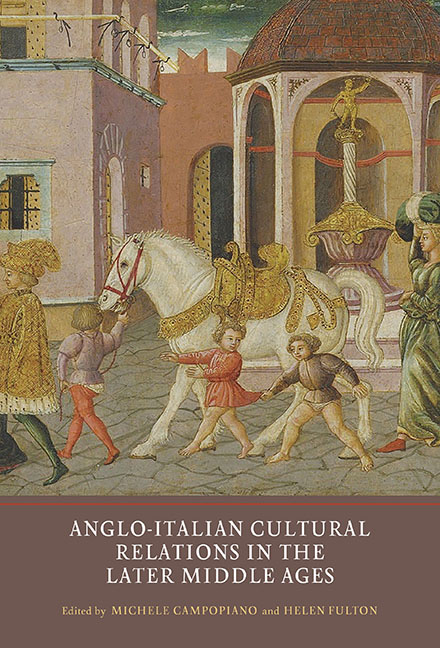Book contents
- Frontmatter
- Contents
- List of Illustrations
- List of Contributors
- Acknowledgements
- List of Abbreviations
- Introduction: Historical and Literary Connections between Britain and Italy in the Middle Ages
- 1 Writing, Translating and Imagining Italy in the Polychronicon
- 2 Richard de Bury, Petrarch and Avignon
- 3 The Reception of Italian Political Theory in Northern England: Bartolus of Saxoferrato and Giles of Rome in York
- 4 Italian Firms in Late Medieval England and their Bankruptcy: Re-reading an Old History of Financial Crisis
- 5 ‘Nostri Fratelli da Londra’: The Lucchese Community in Late Medieval England
- 6 ‘Saluti da Londra’: Italian Merchants in the City of London in the Late Fourteenth and Early Fifteenth Centuries
- 7 Political Joachism and the English Franciscans: The Rumour of Richard II's Return
- 8 Urban History in Medieval and Early Modern Britain: The Influence of Classical and Italian Models
- Afterword: The Nature of Anglo-Italian Cultural Exchanges
- Bibliography
- Index
1 - Writing, Translating and Imagining Italy in the Polychronicon
Published online by Cambridge University Press: 03 July 2019
- Frontmatter
- Contents
- List of Illustrations
- List of Contributors
- Acknowledgements
- List of Abbreviations
- Introduction: Historical and Literary Connections between Britain and Italy in the Middle Ages
- 1 Writing, Translating and Imagining Italy in the Polychronicon
- 2 Richard de Bury, Petrarch and Avignon
- 3 The Reception of Italian Political Theory in Northern England: Bartolus of Saxoferrato and Giles of Rome in York
- 4 Italian Firms in Late Medieval England and their Bankruptcy: Re-reading an Old History of Financial Crisis
- 5 ‘Nostri Fratelli da Londra’: The Lucchese Community in Late Medieval England
- 6 ‘Saluti da Londra’: Italian Merchants in the City of London in the Late Fourteenth and Early Fifteenth Centuries
- 7 Political Joachism and the English Franciscans: The Rumour of Richard II's Return
- 8 Urban History in Medieval and Early Modern Britain: The Influence of Classical and Italian Models
- Afterword: The Nature of Anglo-Italian Cultural Exchanges
- Bibliography
- Index
Summary
In the last two decades, scholarship has taken the Latin Polychronicon out of the cobwebs, reflecting on its historiographical geography and materialist history in the light of such concepts as transnational, national and local identities. In the course of these reflections, as well as in recent genre-focused studies of the place of antiquity in universal history, the Polychronicon's visual and verbal representations of Rome – especially as they relate to Britain – have played a non-negligible part. While I am indebted to many of the insights provided by these studies, what I propose here is both more straightforward and more ambitious: I wish to explore and reflect on the Polychronicon's cartographic, chorographic and historiographical space of an ‘Italy’ that is inclusive of, but also in excess of, Rome. Since the near ubiquity of this space precludes exhaustiveness, I will focus on some of its recurring features that may help us assess the place of Italy in the historico-geographical imaginary at a time when the island of Britain is already linked to the Italian peninsula by commercial and mercenary activity, but the works of the great trecento authors have yet to make an impact on English literature.
The ‘writers’ of the Polychronicon were multiple, and for the purposes of this study can be defined as three: the Chester Benedictine Ranulph Higden, as he revisited and revised an earlier version of his work at some time in the 1350s; John Trevisa, as he worked on his translation for Thomas Berkeley in 1385–87; and the unknown translator behind the only extant manuscript of his work in London, British Library (BL), MS Harley 2261 (c. 1475). Widely circulated, prolifically copied and continued, before and after being translated, the Latin Polychronicon can hardly be apprehended in all its variant versions, so there is little alternative but to refer to the edition by C. Babington and J. R. Lumby, which collates five Latin manuscripts and includes the two English translations.
When using the term Polychronicon in what follows, I will essentially be referring to features of the text that are common to author and translators, whose distinct voices will be referred to as those of Higden (for the writer), Ranulph (when signing additions under his initial R), Trevisa, and Harley 2261.
- Type
- Chapter
- Information
- Publisher: Boydell & BrewerPrint publication year: 2018

